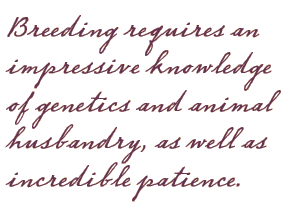 igeons are often stereotyped as dirty street birds, but—as these fashionable fliers in Cairo demonstrate—they can be not only beautiful but even stunning. Take the Jacobins with their regal-looking mane of soft feathers, like Greta Garbo snuggled in a fur coat; Oriental Frills with reversed feathering on their regal chests that resembles a European
cravat; or Frillbacks with their uncanny corkscrew-tight curled feathers.
igeons are often stereotyped as dirty street birds, but—as these fashionable fliers in Cairo demonstrate—they can be not only beautiful but even stunning. Take the Jacobins with their regal-looking mane of soft feathers, like Greta Garbo snuggled in a fur coat; Oriental Frills with reversed feathering on their regal chests that resembles a European
cravat; or Frillbacks with their uncanny corkscrew-tight curled feathers.
Humankind has had a fascination with the pigeon since it was first domesticated about 10,000 years ago, shortly after our other best friend, the dog. In Mesopotamia, pigeons were worshiped as fertility goddesses. The ancient Egyptians used them
to carry information about the Nile’s flood
levels. Pigeons delivered the results of the first Olympics in 776 bce, and more than
2500 years later they brought news to London of Napoleon’s defeat at Waterloo. King Solomon not only sang their praises, but also used them to deliver
critical messages, as did Julius Caesar, Hannibal and Genghis Khan. Ancient Rome was aflutter with pigeons, but the Romans didn’t seem to mind—they took great delight in the birds.
 Until the invention of the telegraph in the mid-1800’s, the fastest and most reliable way to get a message any distance was by pigeon. Julius Reuters built his newsgathering empire on the wings of pigeons. Not long after, Charles Darwin demonstrated his theory of evolution using pigeons, which populate the entire first chapter of his On the Origin of Species. (His editor prodded him to drop all that evolution nonsense and expand on the topic of pigeon breeding, which was all the rage in Victorian England. Darwin declined, although he considered himself a devoted pigeon fancier.)
Until the invention of the telegraph in the mid-1800’s, the fastest and most reliable way to get a message any distance was by pigeon. Julius Reuters built his newsgathering empire on the wings of pigeons. Not long after, Charles Darwin demonstrated his theory of evolution using pigeons, which populate the entire first chapter of his On the Origin of Species. (His editor prodded him to drop all that evolution nonsense and expand on the topic of pigeon breeding, which was all the rage in Victorian England. Darwin declined, although he considered himself a devoted pigeon fancier.)
Coupled with this proud yet nearly forgotten history are the bird’s unparalleled athletic abilities. Pigeons routinely fly 600-mile races without stopping, traveling from a place they’ve never been before and averaging nearly 100 kilometers an hour (60 mph). To put that into perspective, consider that the very best racehorses sprint at about 55 kph (35 mph) around a closed track for a little over a mile.
Like pigeon racers, pigeon breeders worldwide take great pride in their hobby, with many of them spending decades working to produce a “perfect” specimen in their backyard or rooftop aviaries. Success requires an impressive knowledge of genetics and animal husbandry, as well as incredible patience. And, unlike the dog breeders whose craft is publicized annually at the Westminster Kennel Club dog show, pigeon breeders must accept that theirs is a lonelier pursuit, with little or no media attention. But I’ve never met a breeder who much cared about fame: For them, it’s about the birds. They know that pigeons—whether bred for show, racing or simply as a hobby—make wonderful companions.
 |
David Degner (David@IncendiaryImage.com) lives in Cairo. He recently earned his master’s degree in photojournalism from Western Kentucky University where he also majored in philosophy. His recent news photos from Cairo have been published in slide shows by the Wall Street Journal. |
 |
Award-winning journalist Andrew D. Blechman is currently managing editor of Orion magazine. His work has also appeared in Smithsonian, The Atlantic, The New York Times and The International Herald Tribune. More information about his first book, Pigeons: The Fascinating Saga of the World’s Most Revered and Reviled Bird, is available at www.andrewblechman.com. |